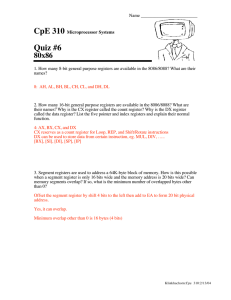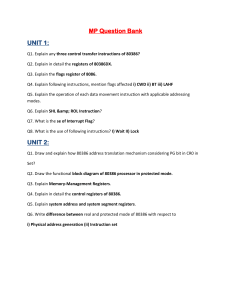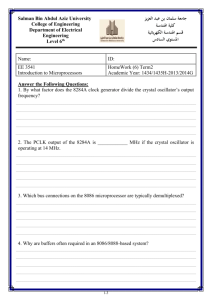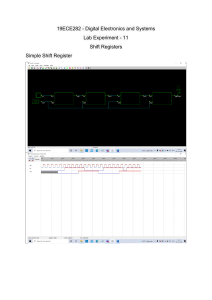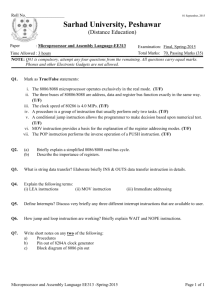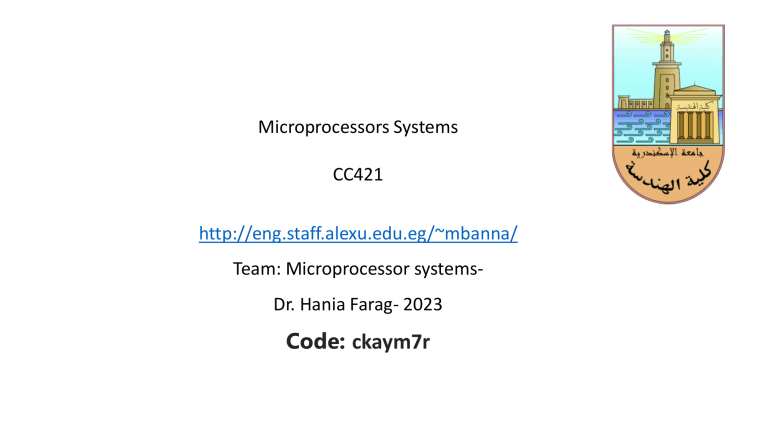
Microprocessors Systems CC421 http://eng.staff.alexu.edu.eg/~mbanna/ Team: Microprocessor systemsDr. Hania Farag- 2023 Code: ckaym7r • Instructors: • Prof. Dr. Mohamed Elbanna • Prof. Dr. Hania Farag • Office: 3rd floor Electrical Engineering Department building • hania.farag@alexu.edu.eg • Office Hours: T.B.A. Textbooks: • Required text: - • THE INTEL MICROPROCESSORS Architecture, Programming, and Interfacing, Eighth Edition by BARRY B. BREY Part I: Software Chapter 1: Introduction There are two big microprocessors families: ◼ Intel (80xxx). ◼ Motorola (68xxx). ◼ The Intel Microprocessors are used in the PCs. ◼ ◼ In this course, we study the Intel Ps. 1.1. Evolution of the Intel’s Ps. Product 8080 8085 8086 8088 80286 80386 80486 Year introduced 1974 1976 1978 1979 1982 1985 Clock rate (MHz) 16-33 25-50 2-3 3-8 5-10 5-10 6-16 1989 27500 1.2 No. Transistors 4500 6500 29000 29000 13000 0 0 million Physical memory 64K 64K 1M 1M 16M 4G 4G External data bus 8 8 16 8 16 32 32 Address bus 16 16 20 20 24 8 8,16 8,16 8,16 32 32 8,16,3 8,16,32 2 Data type (bits) 8 1.1. Evolution of the Intel’s Ps. Product P pro P II P III P4 Year introduced 1995 1997 1978 2000 Clock rate (MHz) 150-166 266-333 1000, 1G 3.2G No. Transistors 21M ? ? ? Physical memory 4-64G 64G 64G 64G External data bus 64 64 64 64 Address bus 32-36 36 36 36 Data type (bits) 8,16,32,64 8,16,32,64 8,16,32,64 8,16,32,64 1.1. Evolution of the Intel’s Ps. • Threads are the virtual components or codes, which divides the physical core of a CPU into virtual multiple cores. A single CPU core can have up-to 2 threads per core • IGP: Stands for "Integrated Graphics Processor." An IGP is a graphics chip that is integrated into a computer's motherboard. The IGP serves the same purpose as a video card, which is to process the graphics displayed on the computer. • Integrated graphics processors take the graphics portion of the processing load off the main CPU. • Core: A core is usually the basic computation unit of the CPU - it can run a single program context (or multiple ones if it supports hardware threads such as hyperthreading on Intel CPUs), maintaining the correct program state, registers, and correct execution order, and performing the operations through ALUs. • TDP stands for Thermal Design Power, and is used to measure the amount of heat a component is expected to output when under load. For example, a CPU may have a TDP of 90W, and therefore is expected to output 90W worth of heat when in use. Intel Corei9 - 9900KS (2020) The Intel Corei9-9900KS is the fastest mainstream processor in Intel’s lineup making it one of the best processor for gaming. All cores run @ 5GHz simultaneously. But, expensive and gets hot. CISC versus RISC • CISC stands for "Complex Instruction Set Computing." This is a type of microprocessor design. The CISC architecture contains a large set of computer instructions that range from very simple to very complex and specialized. • It was later found that many small, short instructions could compute complex instructions more efficiently. • Reduced Instruction Set Computing (RISC), is now the other major kind of microprocessor architecture. • Intel Pentium processors are mainly CISC-based, with some RISC facilities built into them, whereas the PowerPC processors are completely RISC-based. 1.1. Evolution of the Intel’s Ps. ◼ The execution time are given as: 8080 8085 8086/8088 ◼ 2 s 1.3 s 400 ns The advantages of the 8086/8088: ◼ Hardware multiplication and division. ◼ Larger addressable memory space. ◼ Large number of internal registers which are accessible in 200 ns. 1.2. 8086/8088 Architecture ◼ The steps of fetching and executing the instruction: 1. 2. 3. An instruction is fetched from memory, then it is decoded within the P. Operands are read from/written to either the data segment memory or internal registers. The P is now ready to execute the next instruction. ◼ The main purposes of the BIU are: To keep the prefetch queue filled with instructions. 2. To generate and accept the system control signals. 3. To provide the system with the memory address or I/O port number. 4. To act as window between the EU and memory for data. 1. ◼ ◼ ◼ The prefetch queue is FIFO memory. The 8086 queue is 2 byte-wide queue and 3 locations deep. The 8088 queue is a byte-wide queue and 4 bytes deep. 1.2.1.2. Execution Unit (EU) ◼ ◼ ◼ ◼ The EU carries out instructions that are fetched from the prefetch queue. The ALU performs arithmetic and logic operations on memory or register data. The register array holds information temporarily The instruction register 1. Receives the instruction from the prefetch queue. 2. Decodes the instruction to be executed. 1.3. 8086/8088 Memory 8086/8088 has 1M (1,048,576) Byte. ◼ The memory can be studied from two points- ofview: ◼ The programmer Logical Memory. ◼ The hardware designer Physical Memory. ◼ 1.3.2. Physical Memory ◼ The advantages of this organization ◼ ◼ is: The 8086 can address any byte or word of data. To transfer 16 bits from/to memory: 8086 requires 1 operation. ◼ 8088 requires 2 operations. ◼ ◼ The 8086 software executes more efficiently. 1.4. Registers ◼ The registers can be divided into: ◼ Data or general purpose registers. ◼ Pointer and index registers. ◼ Segment registers. ◼ Flag register. 1.4.1. General Purpose Registers There are 4 general-purpose data registers. ◼ Used for temporary storage of frequently used intermediate results. ◼ The advantage of storing the data in the internal registers instead of the memory is that they can be accessed much faster. ◼ ◼ The primary functions of these registers include: ◼ AX (Accumulator) 1. Used with the arithmetic and logic operation. 2. Used with the I/O devices ◼ BX (Base) 1. Hold the base address of data located in the memory. 2. Hold the base address of a table of data referenced by the translate instruction (XLAT). ◼ The primary functions of these registers include: ◼ CX (Count) 1. Used as a counter for certain instructions such as shift rotate and loop. 2. Used as a counter for the string operations. ◼ DX (Data) 1. Used with the arithmetic instruction such as 16- bit multiplication and division. 2. Hold the I/O port number for a variable I/O instruction.

